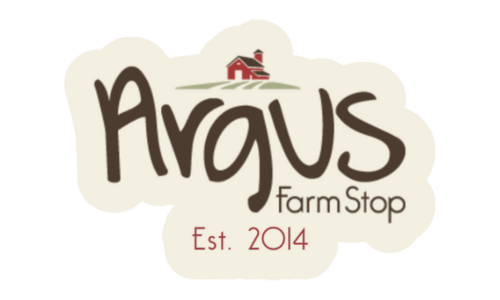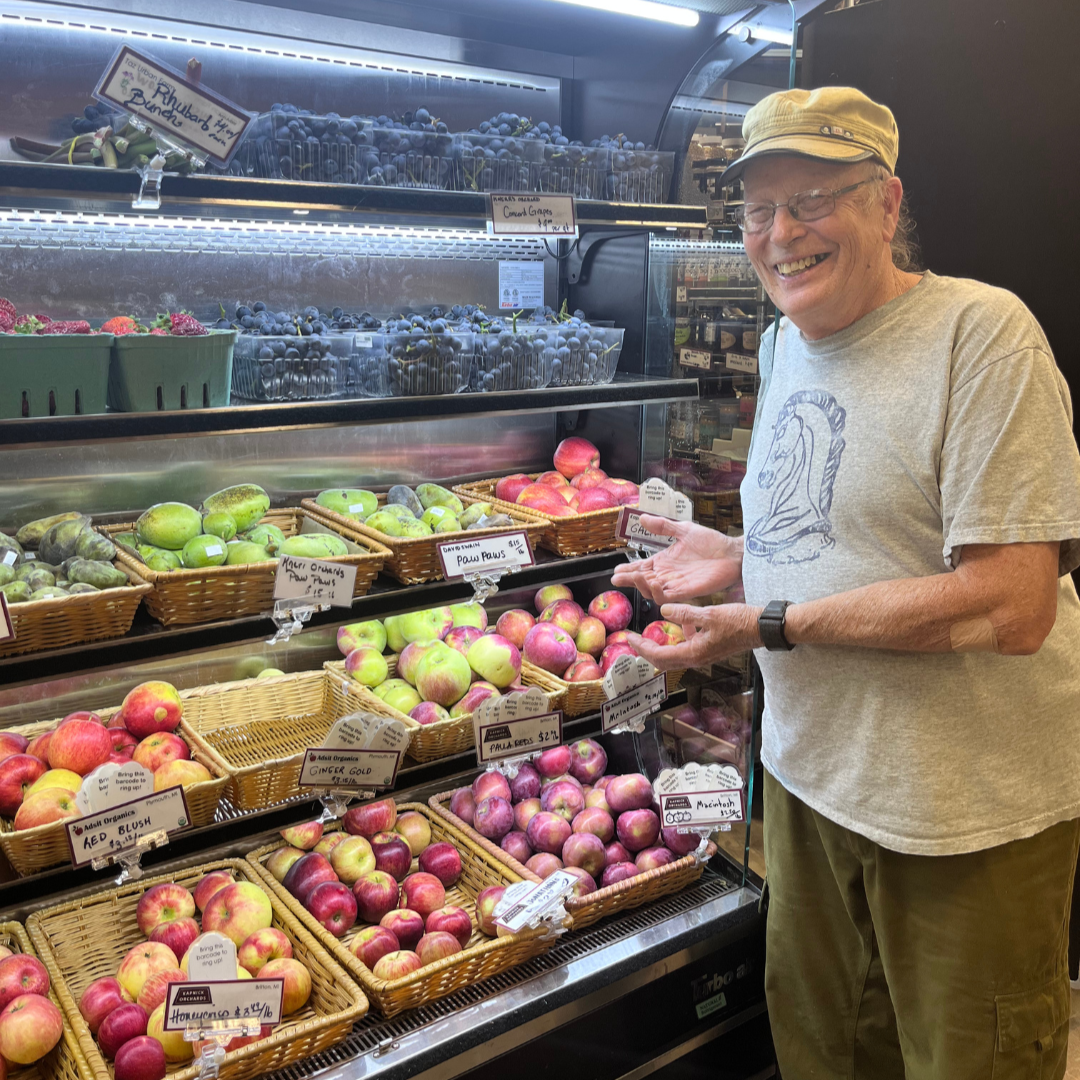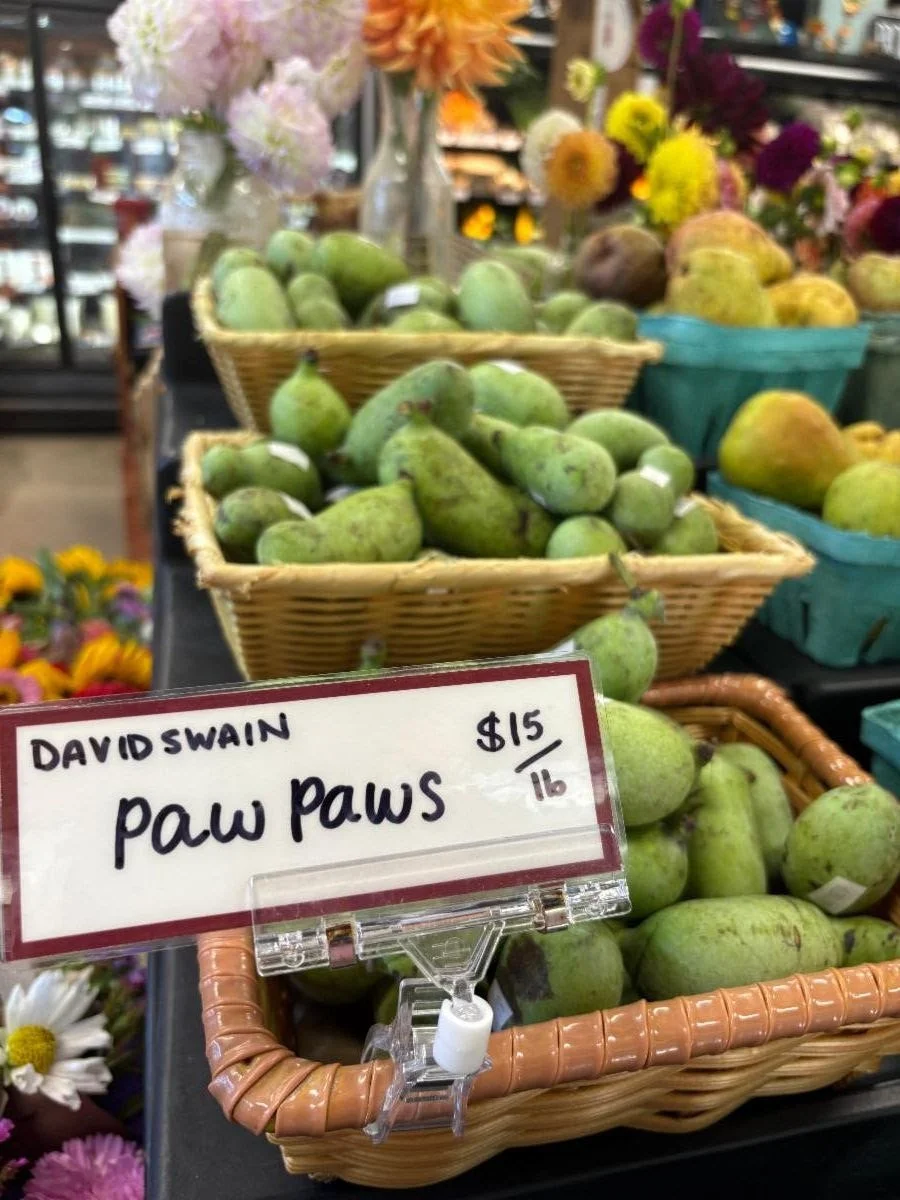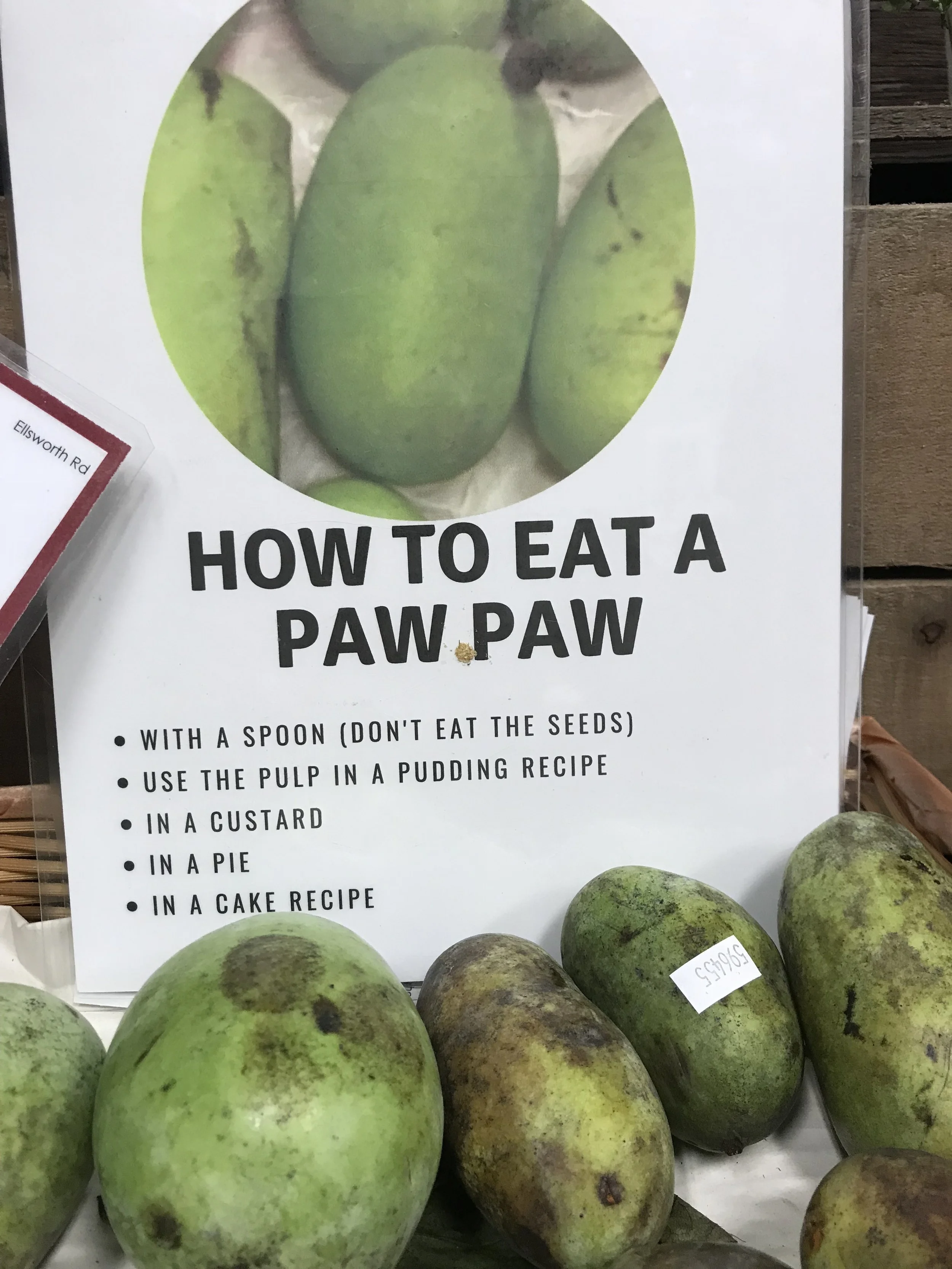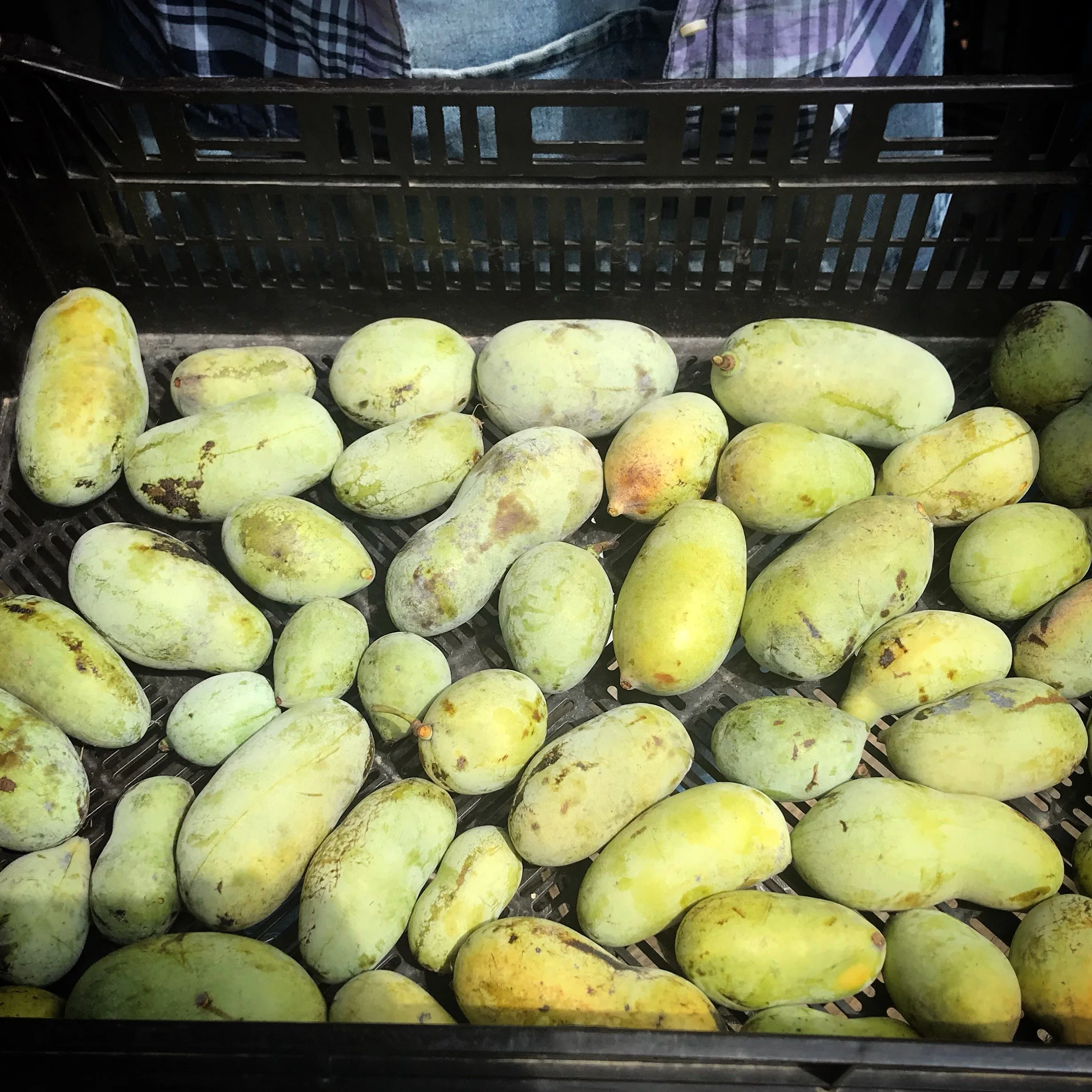Michigan’s Native Fruit: Paw paws with David Swain
David Swain with his crop of paw paws this year at Argus Farm Stop - Packard Market
As the weather begins to cool and leaves change color, a very special fruit makes its way to Argus Farm Stop. North America’s only native fruit tree yields its harvest in the form of the Paw paw, a fruit that is native to the American Midwest. Despite living in the Midwest for the past seven years, I had never heard of a paw paw until I began working at Argus Farm Stop. I have thankfully come to understand how special this fruit is. It has a custard-like texture, and tastes like a cross between a banana, mango, and papaya. Alex Blume and I spoke with one of our paw paw farmers, David Swain, about his process for growing and harvesting this novelty fruit.
Immediately upon beginning the interview, David’s passion for growing paw paws became apparent. He has been growing them for the past fifteen years out of his backyard, making his home a “suburban farm.” Since 2010, he has planted and cared for 50-60 paw paw trees.
Given how many people love paw paws and how few stores offer them, David felt there was an unmet need for growing them. Many people in Michigan and Ohio were overlooking the fruit simply because they didn’t know much about it. Sharing the beauty of this native fruit inspired him to start growing his own.
“They’re so exotic, but they’re native to Michigan. They grow within a few miles from here. People always overlook them because they’re so persnickety, and there’s not much time getting them from the tree to the user before they turn to mush. The few weeks they’re in season over here, I come down to share my bounty.”
What is the history of paw paws, and why are they the only culinary fruit tree native to North America? David’s love of paw paws extended to his knowledge of their history, as he enlightened us to how their history represents the ancient history of the American Midwest.
“When the glaciers receded 13,000 years ago, that was what was here. [Paw paws] were designed for the megafauna—the mastodons, giant sloths, and mammoths. They would eat the fruit, and as they made their rounds, their excrement had the seed in it, which would make the soil fertile. That’s how the trees spread.”
David works hard to care for each tree, while also trying to stay true to how they would survive in nature. The health of the tree is a system that involves healthy soil and insect activity.
“I give them as much attention as they would get in the wild. There’s no real pests or things that prey on them, except the butterflies that sometimes lay eggs in them. It takes two trees to germinate, and all kinds of little things do it—like little tiny flies; carrion flies—so sometimes if people aren’t getting fruit, to attract more carrion flies, they’ll plant something like roadkill below the trees. But mine have been there for a while, so the flies know where I’m at.”
Another reason paw paws are a mystery to much of our community is the question of how to enjoy one. Paw paws start off very hard and bright green, but this is not the time to enjoy one. You want to wait for the fruit to get quite soft, and lose much of its bright green color. You shouldn’t eat the skin or the seeds inside. Paw paws can be made into other dishes but David’s favorite way to eat them is straight from the tree.
“I enjoy them best when they’re right there, sitting in the shadow of the tree. They’re also great in smoothies and ice cream. It’s my understanding it can be an issue if you cook with them, that some people have an allergic reaction. You can bake bread with it, but it’s not as sure a thing as ice cream. You can also freeze the pulp if you have more than what you can deal with.”
In telling when they are ready to eat, David’s biggest indicator is the smell of the fruit.
“You can smell it, and they’ll be soft to the touch. Some people like them when they’ve turned completely black and they have a more caramel taste, and almost like a fermented flavor.”
You usually won’t see any paw paws at the traditional super markets and grocery stores. Why is it that such a unique fruit that’s harvested in our community isn’t making its way to the stores where most people are buying food? Part of the reason is the fact that a paw paw is best enjoyed when it doesn’t look as appetizing compared to most of our usual fruit. When most people would consider a banana too far gone is when a paw paw is best enjoyed. Transportation plays a big role as well.
“They go from being unripe to too ripe very rapidly, and they don’t travel well. If I’ve got a bunch of paw paws, I get a bunch of grocery store plastic bags to deliver them in, because the plastic supports the whole thing. If you lay them in a box, the weight will affect them, so you can’t stack them up at all. They’re very delicate.”
Argus Farm Stop is one of the most reliable places in Ann Arbor to get paw paw fruit in season. Our model of supporting small to medium sized farms, and spreading the knowledge of local food through customer service enables us to support paw paw farmers and paw paw shoppers alike. The paw paw fruit thus does a great job of representing the difference between shopping direct from local farms and shopping from traditional grocery stores and supermarkets. They also show how the over reliance on these uber-convenient channels has changed our diets, and our shopping habits.
“Before they had bananas year round, people ate a lot more paw paws and persimmons. Most other fruits that grow here are from somewhere else, like apples and peaches. Those come from the old world, but this is something that’s been here for 13,000 years. A lot of places became developed and they disappeared, and so much of where [paw paws] live now is just the armpit of the county. They live in the floodplains, or a lot of times, land that other trees just don’t grow on.”
David expressed his gratitude to have Argus Farm Stop to sell paw paws. “Argus” has been something that’s followed him all of his life in Ann Arbor.
“Argus was a camera manufacturer that had a couple factories here—one on Huron and Glen and the other on the old Westside and Fourth. When they were gone, there was an underground newspaper here called ‘The Argus,’ and I wrote and did production work for them. Their office was about four blocks from here [Argus Farm Stop]. Now I sell here, and I really appreciate all of the effort you guys put in on our behalf.”
If you are hoping to try Michigan’s only tropical fruit, you can find them at both Argus Farm Stop locations, where David and several other local farmers offer their paw paws for sale. David otherwise shares his harvest with friends and neighbors. He says the best way to enjoy the fruit though is to grow your own trees.
“Anybody who buys a paw paw has enough seeds for a whole patch. If you put them in the ground, they will come up late, usually the next year in July, but they grow here, and those big old seeds have lots of umph. Even if you’re out somewhere on a picnic and you’ve got paw paws, just toss some seeds out on the side, because you never know what you’re gonna find.”
Paw paws can only be enjoyed by Michiganders in large part because people like David decide to share their knowledge and keep the native trees alive here in Michigan. Argus Farm Stop is grateful to have him share his harvest with us for these few special weeks each year, and we encourage you to give them a try while they’re still here! Also, check out a recipe for paw paw pudding below, found by our farm stop dietitian Mary Balog!
—————————————————————————————————————————————————————————-
Baked Pawpaw Pudding with Homemade Whipped Cream
Paw paws are known for their creamy, custard-like texture and tropical flavor, similar to banana, mango, and pineapple. They're ideal for desserts like quick breads, pies, and puddings. Only the pulp is edible. Both the skin and seeds are toxic. Ripe paw paws yield slightly to touch and may have dark spots. To use, cut the fruit in half, scoop out the pulp, and discard the skin and seeds. The pulp is highly perishable but freezes well for later use.
Ingredients:
½ cup (1 stick butter, melted and slightly cooled, plus more for baking dish
2 cups sugar
1½ cups all-purpose flour
1 teaspoon baking powder
¼ teaspoon salt
½ teaspoon ground cinnamon
¼ teaspoon ground ginger
¼ teaspoon ground nutmeg
3 large eggs
2 cups pawpaw pulp
1 ½ cups whole milk
1 teaspoon vanilla extract
Homemade whipped cream:
1 cup heavy cream or heavy whipping cream, cold
2 Tablespoons granulated sugar or confectioners’ sugar
1/2 teaspoon vanilla extract
Directions:
Make the whipped cream: In a large bowl using a hand-held or a standing mixer, fitted with a whisk attachment, whip the heavy cream, sugar, and vanilla extract on medium-high speed until medium peaks form, about 3–4 minutes. Medium peaks are between soft/loose peaks and stiff peaks, and are the perfect consistency for topping and piping on desserts. If you accidentally over-whip the cream, and it looks curdled and heavy, pour in a little bit more cold heavy cream, and fold it in gently by hand with a spatula until it smooths out. Cover tightly and store in the refrigerator until use, for up to 24 hours.
Heat oven to 350 degrees. Grease a 13-by-9-by-2-inch baking dish.
In a large bowl, whisk together sugar, flour, baking powder, salt, cinnamon, ginger and nutmeg.
In another large bowl, whisk together eggs and pawpaw pulp until smooth. Whisk in milk and vanilla. Whisk in melted butter. Pour into sugar mixture and stir only until combined.
Pour batter into prepared dish. Bake 50 minutes or until just set in the center. Cool to room temperature on a wire rack before cutting. Serve with a dollop of whipped cream.
Source: NYT Cooking and Sally’s Baking
